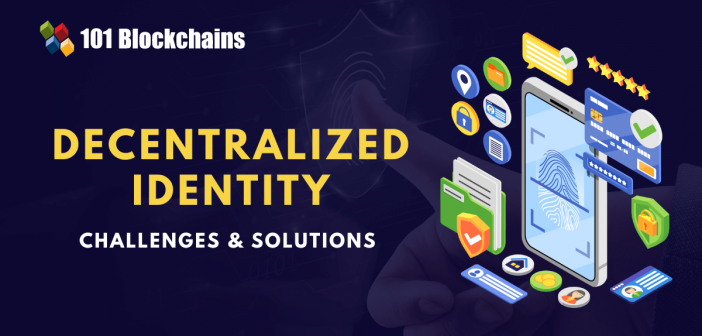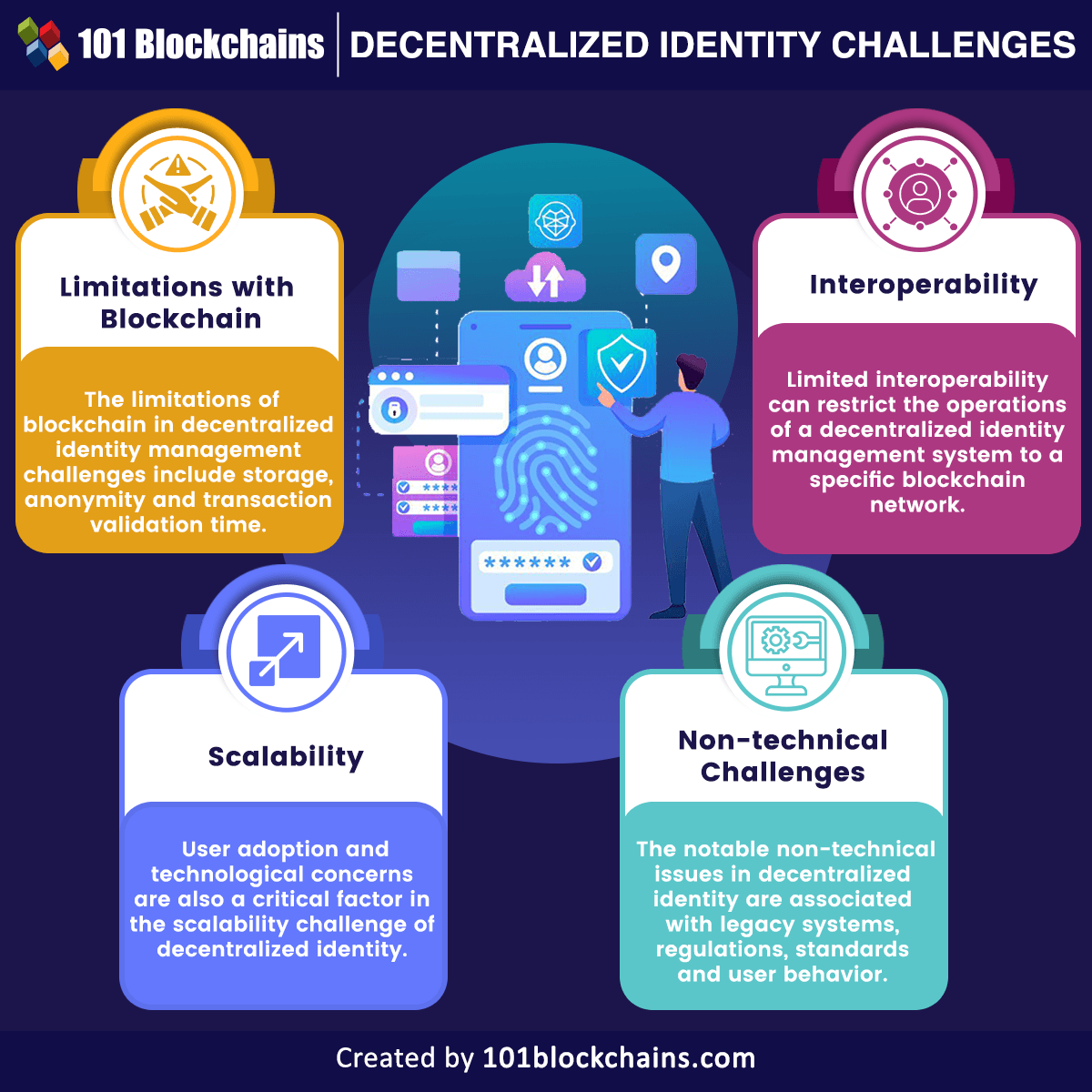Learn how blockchain truly works, master key definitions, and uncover what makes smart contracts so "smart." Dive into the fundamentals, gain valuable insights, and start your blockchain journey today!

- Guides
James Howell
- on April 28, 2023
Decentralized Identity – Challenges & Solutions
Web3 has introduced many prominent technological advancements, and decentralized identity is one of the most notable among them. The world has been transitioning towards digital transactions in almost every aspect of life, ranging from governance to commerce. Therefore, digital identity solutions are an inevitable requirement for enabling seamless access to different online services and applications.
Decentralized identity systems offered the solution to the privacy of user information in digital identities by introducing blockchain into the equation. However, decentralized identity challenges have been affecting the prospects for the adoption of DID. What are the prominent challenges in the domain of decentralized management? Decentralized identity has evolved as a popular solution for scaling up digital identities according to new technological advancements and attack vectors.
The emphasis on answers to “What problem does decentralized identity solve?” along with a review of the existing state of decentralized identity can help you understand the need for learning about challenges with decentralized identity. Third-party agents hold the identity information of users, and decentralized identity helps in removing such intermediaries. On the other hand, the implementation of a decentralized identity accompanies some critical challenges. The following discussion will help you identify the prominent issues facing decentralized identity and the best ways to solve them.
Excited to learn the concept of decentralized identity on existing digital ecosystems? Join Yearly/Yearly+ Plan and get free access to Decentralized Identity Fundamentals Course Now!
The Necessity of Decentralized Identity
The best way to start your search for decentralized identity challenges and solutions would be to learn about their importance. The daily life of an individual in the 21st century is incomplete without the internet. Radically growing levels of online activity have resulted in a groundbreaking shift of identities from physical to virtual spaces, thereby resulting in the development of digital identities.
Generally, a centralized institution stores and manages the digital identities of individuals. For example, you have to enter your personal information to sign up with an email service to create an account and use their services. In return for the services provided by the centralized platform, you have to give up control over your personal information. Users have to rely on the security measures of the centralized platform to safeguard their personal information.
Why do you have to bother about decentralized identity solutions when centralized identity systems get the job done? The answer would point to the recently discovered drawbacks of centralized identity management systems. Many incidents have proved that centralized systems have vulnerabilities in safeguarding user security and privacy.
For example, the Cambridge Analytica scandal revealed how a political consultancy firm used the personal data of Facebook users. In addition, the security breach at Equifax, a credit-rating firm, resulted in the exposure of the personal information of around 147 million users. Another important concern of centralized identity management points to users allowing permissions for websites to use their personal data.
Build your identity as a certified blockchain expert with 101 Blockchains’ Blockchain Certifications designed to provide enhanced career prospects.
How Does Decentralized Identity Help?
The security concerns in centralized identity management imply the necessity of developing new digital identity systems focused on user privacy. You can find answers to “What problem does decentralized identity solve?” in the potential for innovation in the use of technology. You can use technology to create mechanisms that could safeguard the identity of an individual and restrict access to unauthorized individuals.
On top of it, technology can help in verifying identity validity without exposing the personal information of users. Which technology can help in achieving all these improvements? The ideal response would direct you toward blockchain technology. Compared to centralized identity management systems, blockchain introduces a decentralized approach to identity data management.
Decentralized works by using blockchain to offer sovereign control over digital identities to the users themselves. Without governments, big tech companies, or other commercial entities working as intermediaries, blockchain ensures that users control their digital identities.
Existing State of Decentralized Identity
The importance of decentralized identity validates the urgency for seeking information about the challenges affecting decentralized identity. Many decentralized identity management projects have been initiated in recent times. While the opportunities with decentralized identity are endless, it is also important to identify the challenges for the development and expansion of decentralized identity systems. How can you identify the formidable challenges in the decentralized identity ecosystem? You can find the answer in a review of the existing states of decentralized identity systems. Here are some of the notable highlights of the existing decentralized identity ecosystem.
-
Digital Identity
The digital identity of an individual is the foremost highlight of decentralized identity. You can find three important factors in the digital identity of an individual, including identification, authorization, and authentication. Identification points to essential information about the user, such as their personal information or service usage data. Authentication ensures validation of the information provided by the individual in the identification step through authentication credentials. In the final stage, authorization deals with determining the operations which users can access according to their digital identity.
-
Self-Sovereign Identity
Self-Sovereign Identity, or SSI, presents a unique user-centric approach to managing digital identities. The introduction to decentralized identity solutions with SSI allocates complete control and ownership of user data to users. Some of the key highlights of SSI refer to the control over user data, complete data portability, transparency into changes, and implications of authentication, privacy, and security.
-
Decentralized Identifiers
The concept of SSI provided a massive boost to the development of a decentralized identity ecosystem with decentralized identifiers or DIDs. DID offer an identification system that can assign a standard and permanent identity that is universally unique. The decentralized identifier features cryptographic verifiability, thereby removing the need for centralized authorities. Decentralized identifiers can use a public-private key combination to verify their identity without disclosing personal information.
Start learning Blockchain with World’s first Blockchain Skill Paths with quality resources tailored by industry experts Now!
-
Blockchain
Decentralized identifiers serve as an effective answer to “What problem does decentralized identity solve?” by creating an environment of privacy, credibility, and security. However, decentralized identifiers must rely on blockchain technology as the foundation. Distributed ledger technology helps in offering the ideal infrastructure for creating truly decentralized identity systems. The different traits of blockchain could help in facilitating all the important requirements of self-sovereign identity. How?
Blockchain is decentralized and does not involve any centralized authority, thereby offering complete control of data to the users.
The public-key cryptography, alongside hashing mechanism in blockchain, facilitates an authentication mechanism for identity verification while securing user data privacy. In addition, the distributed nature of blockchain prevents a single point of failure, thereby ensuring the security of user data.
Distributed ledger technology also ensures the portability of data among different users and entities within an identity management system.
The immutability and transparency of blockchain help in the proactive identification of modifications in the data on the blockchain.
Curious to learn about blockchain implementation and strategies? Enroll Now in Blockchain Technology – Implementation And Strategy Course!
Example of Decentralized Identity
Another crucial aspect in understanding decentralized identity challenges refers to an overview of practical decentralized identity systems. One of the most practical examples of the use of decentralized identity points to verifiable credentials. Microsoft demonstrated a comprehensive example of adopting decentralized identity systems through verifiable credentials.
According to the example shown by Microsoft, universities can issue DID-based diploma certificates, which students can save in their identity hub. The verifiable credential proves that the credential issuer, i.e., the university, has authenticated and verified the diploma of students through digital signatures. Students can offer partial access to their diploma certificates through verifiable credentials for proving the validity of their educational qualifications to employers.
The example proves that students can use decentralized identity solutions like verifiable credentials to avoid the need to depend on universities. In addition, universities can also benefit from cost-saving and time efficiency in issuing credentials to students. However, the growing adoption of decentralized identity systems has brought many problems to the forefront.
Start your blockchain journey Now with the Enterprise Blockchains Fundamentals – Free Course!
What Are The Prominent Challenges for Decentralized Identity?
The different highlights in the fundamentals of decentralized identity and the existing state of the decentralized identity ecosystem prove how decentralized identity offers favorable outcomes in identity management. On the contrary, the search for decentralized identity challenges and solutions is essential for paving better paths to growing decentralized identity. Here are some of the prominent challenges you can come across in the domain of decentralized identity.

Please include attribution to 101blockchains.com with this graphic. <a href='https://101blockchains.com/blockchain-infographics/'> <img src='https://101blockchains.com/wp-content/uploads/2023/03/Decentralized-Identity-Challenges.png' alt='Decentralized Identity Challenges='0' /> </a>
-
Limitations with Blockchain
Do you think that blockchain could be responsible for challenges to decentralized identity? The blockchain serves as the most efficient distributed ledger technology for decentralized identity systems. It helps in storing decentralized identifiers and could also help in automatic business workflows alongside facilitating verifiable credentials. The prominent limitations of blockchain in decentralized identity management challenges include storage and anonymity. In addition, the transaction validation time on blockchain networks also presents a challenge for the creation of decentralized identifiers.
Aspiring to make a lucrative career as a blockchain developer but not sure how? Check the detailed guide Now on How To Become Blockchain Developer?
-
Scalability
The limitations of blockchain are responsible for creating scalability issues. Most of the decentralized identity solutions have encountered problems with user adoption and technological concerns. The technological aspects of decentralized identity challenges for scalability focus on the diminishing throughput rate with the expansion of the user base.
Without processing speeds at par with centralized systems, decentralized identity systems are less likely to find any takers in the market. User adoption is also a critical factor in the scalability challenge. Apart from the slow transaction speed on blockchain networks, the complex concepts in decentralized identity systems can affect user adoption. Therefore, decentralized identity systems need to offer simpler user experiences, just like creating usernames and passwords in centralized identity systems.
-
Interoperability
Interoperability has also evolved as a prominent challenge in the domain of decentralized identity systems. It is important to note that interoperability is a significant challenge for blockchain networks. The primary reason for interoperability issues in decentralized identity solutions refers to the distinct traits of each blockchain.
Every blockchain network has its unique considerations for security, usability, and integrity. As a result, interactions between ledgers are becoming difficult. The different blockchain-related projects in Github repositories show that different projects use unique specifications, programming languages, and consensus mechanisms.
Therefore, integration among blockchain projects is considerably complex and challenging. Limited interoperability can restrict the operations of a decentralized identity management system to a specific blockchain network. As a result, you can encounter problems with achieving desired improvements in user adoption rates.
Aspiring to make a lucrative career as a blockchain expert but not sure how? Check the detailed guide Now on How To Become A Blockchain Expert
-
Non-technical Challenges
The list of challenges for decentralized identity systems would also draw attention to non-technical factors. Some of the notable non-technical issues are associated with legacy systems, regulations, standards, and user behavior. Most of the decentralized identity solutions have to embrace the shift from legacy systems by leveraging trust anchors. For example, banks and government agencies should work on adapting their identity management infrastructures according to new decentralized models.
The next big non-technical issue with decentralized identity is the lack of standardization. Standards could help in defining the methods for reading and verifying decentralized identifiers alongside their documents. Lack of standards could result in prominent decentralized identity challenges, such as silos of decentralized identity service providers with their own formats and credentials.
The non-technical challenges in decentralized identity also refer to regulations. Without a clear regulatory framework for decentralized identifiers, it is difficult to address the concerns of liability in the case of breaches or abuse of private user data. Furthermore, user behavior also emerges as a formidable concern for decentralized identity systems. For example, weak passwords, password theft, or consistent use of the same passwords can affect the integrity of decentralized identity systems.
Aspiring to make a lucrative career as a blockchain engineer but not sure how? Check the detailed guide Now on How To Become A Blockchain Engineer
Solutions for Challenges in Decentralized Identity Systems
The adoption of a decentralized identity can present a new perspective on identity access and management systems. However, it is important to understand the implications of the decentralized identity challenges and solutions for the adoption of decentralized identity. Here are some of the recommended solutions to the notable challenges in the existing decentralized identity ecosystem.
-
Layer 2 Solutions
Layer 2 solutions offer a formidable solution to the scalability issue in blockchain, thereby helping decentralized identity systems. Decentralized identity systems can use an additional protocol, the layer 2 protocol, for transferring transactions away from the main blockchain network. As a result, layer 2 solutions can reduce the processing burden of the main blockchain on which the decentralized identity system is deployed.
The best example of such solutions is the Microsoft ION, a public DID system, which utilizes SideTree, a layer 2 protocol based on the Bitcoin blockchain. The implementation of layer 2 protocols for a decentralized identity management system can help in improving transaction speed, thereby achieving scalability. On top of it, the assurance of faster transaction speeds guarantees better user adoption rates.
-
Decentralized Identity Wallets
User experience is one of the prominent challenges in developing new decentralized identity systems. The focus on answers to “What problem does decentralized identity solve?” can fade away when users face complexities in using the decentralized identity. Therefore, a customer-facing solution in the form of a decentralized identity wallet app can offer a flexible way for users to leverage the capabilities of a decentralized identity system. Decentralized identity wallets can offer access to identifiers, credentials, and private keys. Users can interact with one another, verify their identities and send credentials with the help of the decentralized identity wallet.
Want to become a bitcoin expert? Enroll Now in Getting Started with Bitcoin Technology Course
-
Solutions for Interoperability
The discussions about decentralized identity solutions to interoperability challenges bring many alternatives into the equation. Some of the favorable solutions to interoperability challenges refer to integration among distributed ledgers, interoperable digital wallets, and universal resolvers. The cross-platform compatibility between blockchain platforms could help in blending the competencies of both platforms.
In addition, decentralized identity developers can seek solutions for interoperability in the form of interoperable decentralized identity wallets. Such wallets could not only help users in managing their public and private keys but also have a simpler process for user authentication and credential transfers. For example, developers could use protocols like BIP-32 to enable interoperability across digital wallets.
Another prominent highlight in the outline of decentralized identity management challenges and solutions refers to the Universal Resolvers. It is a unique solution for the integration of multiple decentralized identity systems by using a single resolver. Each decentralized identity system should use application logic for linking its methods for processing decentralized identities with the Universal Resolver. As a result, decentralized identity management systems could interact with each other through a common interface. Interestingly, the DID systems do not have to adapt to other application specifications by using the Universal Resolver.
-
Solutions for Standardization
The outline of decentralized identity challenges also emphasizes specifically on lack of standards. Decentralized identities offer a significant advantage by representing a single version of the truth. Standards for issuing, ownership, and verification of decentralized identities help in ensuring secure, verified, and trustworthy storage and transfer of decentralized identity credentials.
For example, passports follow a certain set of international standards, which make them acceptable across different countries. Interestingly, progress in the direction of standardization of decentralized identity systems has been fuelled by the efforts of institutions such as the Decentralized Identity Foundation and W3C.
Not sure how to build your career in enterprise blockchains? Enroll Now in How to Build Your Career in Enterprise Blockchains Course!
Conclusion
The overview of decentralized identity challenges and solutions provides a comprehensive outline of the prominent issues affecting decentralized identity adoption. Decentralized identity systems are a new and complicated concept, albeit with many significant improvements over traditional centralized systems.
With the help of decentralized identity, users can gain complete control and ownership of their digital identity. Users can rely on their decentralized identity to access different digital services without disclosing their private information. However, the development of decentralized identity systems should also address the notable challenges with feasible solutions. Learn more about decentralized identities and their role in the web3 landscape in detail right now.
*Disclaimer: The article should not be taken as, and is not intended to provide any investment advice. Claims made in this article do not constitute investment advice and should not be taken as such. 101 Blockchains shall not be responsible for any loss sustained by any person who relies on this article. Do your own research!







